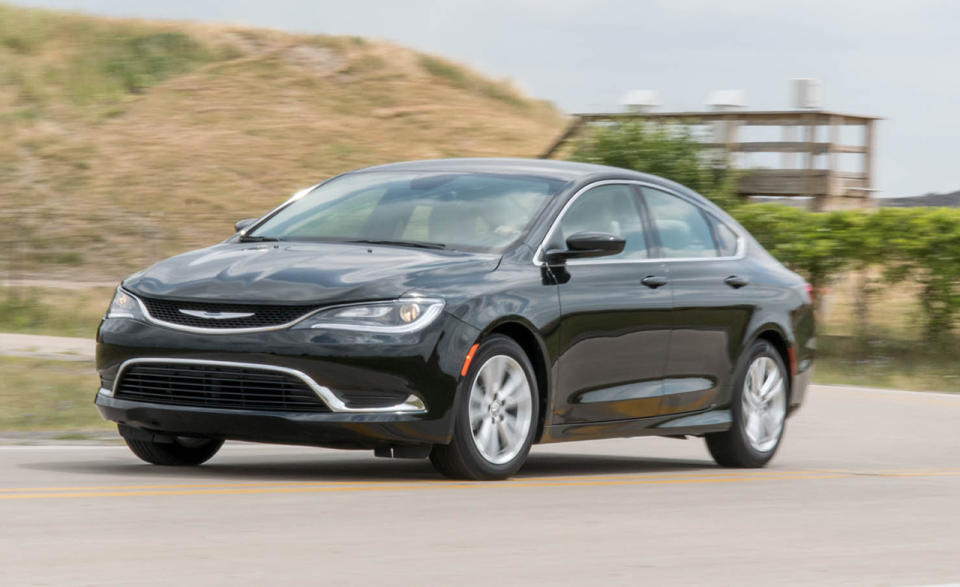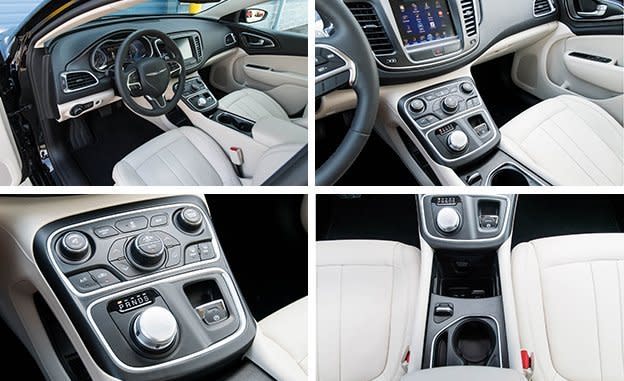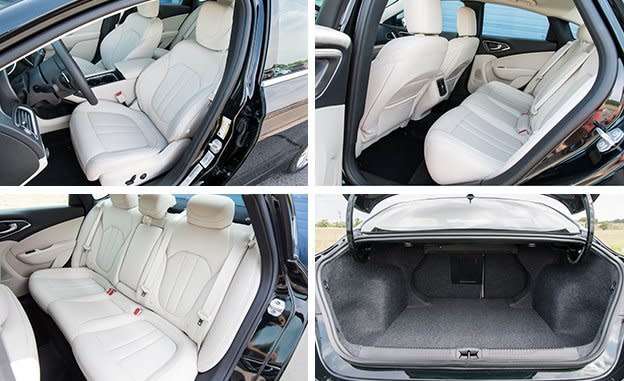2016 Chrysler 200 V-6 FWD

While the news columns are abuzz about the Chrysler 200 (and the smaller Dodge Dart) going out of production later this year, newly built examples are still arriving at dealerships. Priced low and backed by incentives, they’re poised to tempt consumers looking for a deal. We haven’t been particularly impressed by the 200 since the second-generation car came to market in mid-2014 as a 2015 model, but neither have we been so critical as the folks at Consumer Reports, who put the 200 on their Bottom Picks list of the 10 worst cars of 2016.
It’s probably no coincidence that sales of the 200, which came out of the gate strong enough to show FCA gaining a little market share in the hypercompetitive mid-size-sedan segment, fell off a cliff not long after. It’s not all down to CR’s influence: Family-car sales went soft in the rapid market shift to crossovers, Chrysler dialed back on incentives for the 200, and the car squares off against some excellent competitors, including not only the top-selling Toyota Camry and the Honda Accord, but also the Ford Fusion and the excellent new Chevrolet Malibu that stole the spotlight soon after the 200 stepped onto the stage. It’s a tight field in which the differences among trim levels, optional equipment, and price points become as meaningful to the buyer’s choices as those between makes and models.

Even if we’d rather drive our top pick in this segment, the Mazda 6, the 200 is far from hopeless. After previously testing a mainstream 200 equipped with the standard 2.4-liter four-cylinder and a 200S with the 3.6-liter Pentastar V-6 and all-wheel drive, both 2015 models, we expressed hope that later 200s would evolve to close the small gap between the Chrysler and its competitors. Normally, we’d be preparing to write about a midterm refresh on a model so new, but instead we’re saying farewell. The 2016 edition tested here, with a V-6 and front-wheel drive, deserves better.
Sweet Spot in the Lineup
This 200 wore handsome Black Forest Green Pearl paint, so dark it looks black under some lighting conditions, over a Linen and Black interior. Whether or not it’s due to Fiat’s Italian influence, the tastefulness of Chrysler’s color and trim choices has improved dramatically in recent times. Despite some subpar interior materials, this was one of the prettiest examples we’ve seen of the 200, which stylistically doesn’t break away much from the norm in this conservatively designed category. It most resembles the Fusion in profile, but with less sharply creased character lines. Speaking of character, we wish Chrysler had seen fit to give the 200 a more brand-specific face instead of letting it go into the world looking so much like what it is—a slightly longer version of the Dart. Too slightly, it seems, since the wheelbase’s stretch to 108.0 inches leaves it a few shy of the Fusion’s 112.2 or the Malibu’s 111.4 inches. The difference is reflected outside, with longer overhangs and a less appealing stance. Inside, the Chrysler measures a couple of cubic feet short on total interior volume. This is most evident in the rear seat, which mounts too low for comfort in an effort to yield competitive headroom under the sloping roofline. Teens and adults are apt to complain that their knees are higher than their elbows. Front-seat space, by contrast, feels large, and the seats are comfortable, with decent lumbar support and bottom cushions long enough for tall drivers. And the 16-cubic-foot trunk space matches that of the segment leaders.

Our test car was outfitted in Limited Platinum trim, a new designation this year that packs a lot of value. Initially, the base 200LX and the one-step-up Limited offered only the four-cylinder engine, while the sportier 200S and luxury-centered 200C opened the pathway to V-6 and all-wheel-drive options. Late in 2015, Chrysler made the V-6 optional on Limited models (you still need to go for the S or the C to get all-wheel drive). For 2016, the most sought-after options are loaded into the Platinum designation, which wears the same $25,485 base price as the Limited but includes equipment that would have cost $1970 as separate options under the former price structure (an upgrade to the Uconnect infotainment system from the standard 5.0-inch screen to a navigation-capable version with an 8.4-inch screen, plus leather-trimmed bucket seats). The only options on our car were the $1995 V-6 engine (which also brings a leather-wrapped steering wheel, bigger brake rotors, and better interior door trim) and the $695 Comfort and Convenience Group package (remote start, heated seats, dual-zone automatic climate control, power-folding heated exterior mirrors in body color, and illuminated vanity mirrors in the sun visors).
Quicker Than Most
All in, the $28,175 bottom line—before incentives—is easily 20 percent lower than the sticker on a well-equipped V-6 Camry or Accord. Neither Chevy nor Ford offers a V-6 in their 2016 mid-size sedans (Ford has a twin-turbo 2.7-liter V-6 coming for the 2017 Fusion V6 Sport, with standard all-wheel drive, which starts at $34,350 before any options). None of the competitors in this segment still offering six-cylinder power (add Nissan Altima, Subaru Legacy, and Volkswagen Passat to that list) can match the Pentastar’s 295 horsepower or its 262 lb-ft of torque.
The 200 has a nine-speed automatic while most competitors have traditional six-speed automatics; the Nissan has a continuously variable automatic and the Passat a six-speed dual-clutch automatic. The ZF-built nine-speed was problematic in 2015, warranting at least one recall for a quality-control issue involving the wiring harness, and its software needed a couple of updates to address harsh shifting. These woes mostly affected four-cylinder models; the V-6 uses a different version of the same gearbox, and we’ve had fewer complaints about its performance. Whether that’s because the transmission has to shift less often with more torque to work with or because the software was tuned better in the first place, we can’t really say. But aside from an occasional jolt when we dipped deep into the accelerator to trigger a two-gear downshift, it worked well in this car. Shifts were generally smooth, and when the transmission seemed to hold on to a high gear too long in the interest of fuel economy, manual inputs to the little toggle shifters elicited prompt responses. These manual shifters share space behind the steering wheel with audio controls, so there are a lot of controls back there, and they’re smaller than the paddles most automakers offer—when they offer them.
At the track, this 200 ran from zero to 60 mph in a brisk 5.7 seconds, 0.3 second quicker than the 2015 200S AWD, which weighed 267 pounds more. That time ties the V-6–powered VW Passat, one-tenth better than the Camry V-6 and one-tenth slower than the Honda Accord V-6. The 200 also accelerates well in 30-to-50-mph and 50-to-70-mph increments, up at the pointy end of the performance spectrum in a class not known for performance.

The chassis fares a little less well, partly because we’ve yet to meet a 200 wearing tires worthy of its generally good specification and tuning. Like the Dart, the 200 shares its basic architecture with the Alfa Romeo Giulietta (not to be confused with the rear-drive Giulia coming to America), with an independent suspension at both axles and a structure rigid enough to allow engineers to tune the suspension properly. It rides quite well and handles competently, bested mostly by the Mazda and Honda entries we’ve bestowed with 10Best Cars awards. The Goodyear Assurance rubber lets it down on the skidpad, allowing only 0.82 g of grip, although at the track we found it quite stable with only moderate understeer and little attitude change with throttle inputs. We’ve seen a Mazda 6 do 0.87 g, while the V-6 Honda Accord sedan managed 0.83 g and the four-cylinder Chevrolet Malibu, 0.86 g, the Chevy on similar, slightly wider Goodyear rubber. The 200 with the V-6 is quick to light up its inside front tire if you boot the gas in a corner, but it doesn’t go all wonky with torque steer. The brakes are upgraded with the V-6, but only with slightly larger rotors and still dependent on single-piston sliding calipers. The 181 feet this car took to stop from 70 mph is on the long end of family-sedan norms, which aren’t known for stopping any better than they accelerate. Grippier tires would help here, too.
Living with It
We wonder if different tires couldn’t help quell the road noise that some drivers object to in the 200. Our sound meter said this example was 2 decibels quieter at a 70-mph cruise than was the AWD version tested earlier, lending some support to our earlier speculation that the AWD hardware was transmitting noise up through the trunk floor. The V-6 makes more noise at idle and under full throttle than the ubiquitous turbocharged four-cylinders that now dominate the family-sedan world, but even the 69-decibel noise level at cruise that would have earned a “not bad” comment a few years ago now seems loud in a class where 67 has become commonplace and the Malibu generates only 65 decibels. Still, our favored Mazda 6 is louder inside (70 decibels at 70 mph).
It’s not noisy enough to make life unpleasant in the cabin, where Chrysler excels at providing thoughtful storage cubbies and bins throughout—we got into an Accord the next week and wondered where we were supposed to stow all the stuff that we didn’t even worry about in the 200. The Uconnect system, as in other FCA products, stands out for its intuitive ease of use, a short learning curve, and minimal distractions. The Chrysler’s dial shifter worked flawlessly after a little acclimatization period; it wouldn’t be our first choice, but among alternatives to the traditional lever, it’s one of the least offensive. The steering, throttle, and brakes all felt in balance, requiring similar degrees of effort in relation to response. Overall, we’d sooner take this car on a long drive than several of its 10 competitors listed in our Buyer’s Guide, including some that sell in much higher volumes, such as the Camry.
Call us fools for power, deaf to road noise, or simply advocates for cars over crossovers, but we enjoyed our time in the 200 Limited Platinum. No one would mistake it for a sporty car, but it was a pleasant family sedan for commuting and household chores. We think Chrysler is shortsighted in abandoning this crucial segment even for a model year or two. The Sterling Heights, Michigan, factory that assembles the 200 will be converted to produce more high-profit-margin trucks to help the company with its cash flow, problematic due to FCA’s debt load, while it hunts for a partner that could assemble a version of the 200 or a successor model. However that works out, there are a few months left in which buyers could score a value-packed deal.
Specifications >
VEHICLE TYPE: front-engine, front-wheel-drive, 5-passenger, 4-door sedan
PRICE AS TESTED: $28,175 (base price: $27,480)
ENGINE TYPE: DOHC 24-valve V-6, aluminum block and heads, port fuel injection
Displacement: 220 cu in, 3605 cc
Power: 295 hp @ 6350 rpm
Torque: 262 lb-ft @ 4250 rpm
TRANSMISSION: 9-speed automatic with manual shifting mode
DIMENSIONS:
Wheelbase: 108.0 in
Length: 192.3 in
Width: 73.6 in Height: 58.7 in
Passenger volume: 101 cu ft
Cargo volume: 16 cu ft
Curb weight: 3544 lb
C/D TEST RESULTS:
Zero to 60 mph: 5.7 sec
Zero to 100 mph: 14.3 sec
Zero to 120 mph: 22.5 sec
Rolling start, 5–60 mph: 5.9 sec
Top gear, 30–50 mph: 3.1 sec
Top gear, 50–70 mph: 4.2 sec
Standing ¼-mile: 14.3 sec @ 100 mph
Top speed (governor limited): 121 mph
Braking, 70–0 mph: 181 ft
Roadholding, 300-ft-dia skidpad: 0.82 g
FUEL ECONOMY:
EPA city/highway driving: 19/32 mpg

 Yahoo Autos
Yahoo Autos 